
Constantine & the Sacred Name Code ☧ (Chi-Rho)
|  One of the most sacred Greek name codes in the Bible is known as "Chi-Rho". ☧
The code consists of the juxtaposition of the two Greek letters chi "X" and rho "P"
(the 22nd & 17th letters of the Greek alphabet respectively).
The code often is taken to represent the word χριστος (XPRISTOS / Christos)
but may also represent the word χρηστὸς (XPRESTOS / Chrestos).
The code XP (chi-ro), along with the codes XC (chi-sigma), and XPC (chi-rho-sigma)
are commonly found in the Bible, and are taken (with a poetic licence?) to represent Christ (Greek χριστος / Christos).
One of the most sacred Greek name codes in the Bible is known as "Chi-Rho". ☧
The code consists of the juxtaposition of the two Greek letters chi "X" and rho "P"
(the 22nd & 17th letters of the Greek alphabet respectively).
The code often is taken to represent the word χριστος (XPRISTOS / Christos)
but may also represent the word χρηστὸς (XPRESTOS / Chrestos).
The code XP (chi-ro), along with the codes XC (chi-sigma), and XPC (chi-rho-sigma)
are commonly found in the Bible, and are taken (with a poetic licence?) to represent Christ (Greek χριστος / Christos).
Introduction: | A collation of resource notes on nomina sacra (sacred names): Following the Latin Paleographer Ludwig Traube Nomina sacra means "Sacred names" in Latin, and can be used to refer to traditions of abbreviated writing of several frequently occurring divine names or titles in early Greek language Holy Scripture. The Bruce Metzger's book Manuscripts of the Greek Bible lists 15 such expressions from Greek papyri: the Greek counterparts of God, Lord, Jesus, Christ, Son, Spirit, David, cross, Mary, Father, Israel, Savior, Man Jerusalem, and Heaven. The contractions were written with overlines. There has been a dispute about the nature of nomina sacra, whether they represent a mere shorthand or these overlined words indeed bear a sacred meaning. Moreover scholars differ in accounting for the origin and development of the system of Nomina Sacra. The evidence indicates an almost universal use of these codes, in the Greek and Coptic, by both the orthodox and the so-called heretics. The sources of CHRESTOS and CHRISTOS in Antiquity: The "Good" and the "Annointed". The sources of Chrestian and Christian in antiquity: "The disciples were originally called "Chrestians" (not Christians) ..." Ptolemy 246–222 BCE: | Evidence of the chi-rho on coins appears for the first time in the third century BCE on a Greek bronze of Ptolemy III (246–222 BCE). 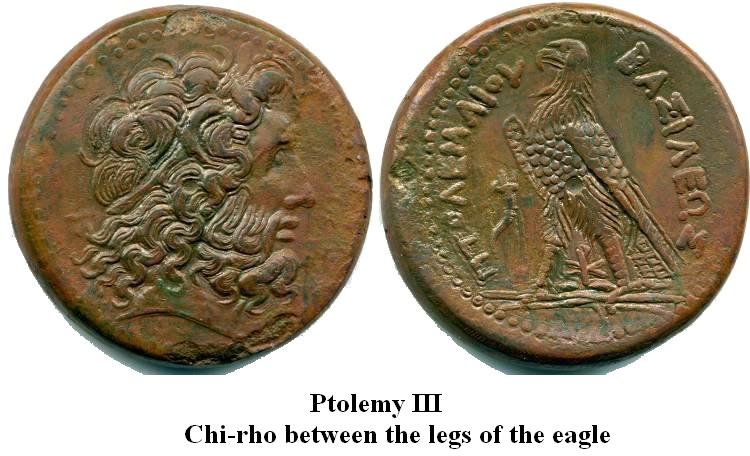
"CENTURION" of the Roman Army | Epigraphic evidence indicates that a CHI above RHO represented an abbreviation for the Greek word ἑκατόνταρχος (hekatóntarkhos) or centurion. To view such a sign Constantine may not have needed to lift his eyes from the battlefield. The historical concept of "Onward Christian Soldiers" takes another meaning. [War is a Racket, SB]
For other examples see pp.110-113, "Abbreviations in Greek Inscriptions", The adjacent inscription is from the "Chapel of the Centurion" discovered at Meggido. 
Constantine: Silver Medalion 316 CE: | The first instance of a chi-rho on a coin of Constantine is on a rare silver medallion issued from Ticinum in 315. Eusebius even stated that Constantine “was in the habit of wearing on his helmet [the chi-rho] at a later period." (Vita Constantini) 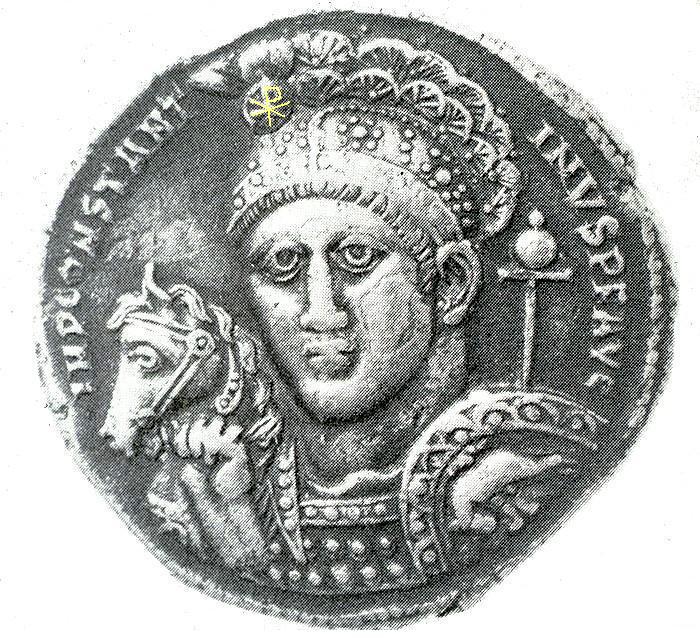
Constantine: Rare Siscia Coin 317 CE (?): | Constantine was always depicted wearing a helmet on all the VLPP coins (except for a very rare issue from Arles). The helmet itself was an important symbol and on some rare issues from Siscia even has a chi-rho in the cross-bar. Constantine had just won the territory of Siscia from Licinius in 317 CE 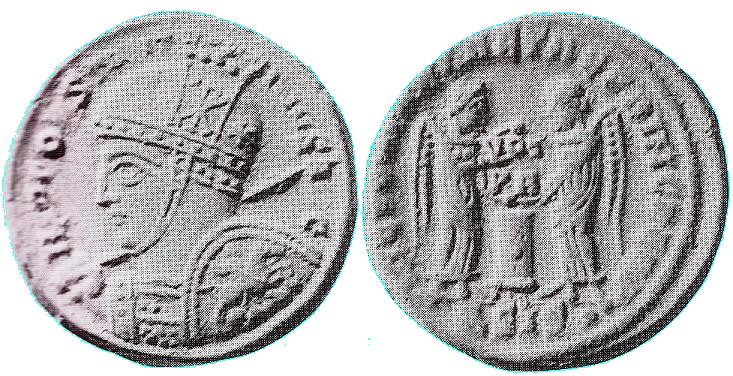
Constantine: Bronze Coin 320 CE: | 18mm 2.4gm CONSTAN-TINVS AVG; Helmeted, cuirassed VIRTVS-EXERCIT; [Valor of the army] Standard inscribed VOT/XX with captive seated on ground on either side, in left field Iota-Chi. in ex. AQP RIC VII Aquileia 58 On the reverse of this coin, in the left field, there is what many call a Chi-Rho. This should probably be called an Iota-Chi, rather than a Chi-Rho, since it looks very little like the Greek Rho and more like an Iota combined with a Chi. On some examples there is a bit of roundness to the top of the Iota, but not enough to call the symbol a proper Rho…at best the symbol might be called a stylized Chi-Rho. Constantine: Commemorative Coin 327 CE: | Civil War II commemorative coinage 327 CE CONSTANTINVS MAX AVG, laureate head right SPES PVBLIC, chi-rho atop standard of 3 medallions impaling snake A to left, CONSA in ex. Constantinople RIC 19 r4 
Constantine: Bronze Coin 336 CE: | 16mm 2.3gm Obv. CONSTAN-TINOPOLIS laureate, helmeted, wearing imperial mantle, holding scepter. Rev. Victory stg. on prow, holding long scepter in r. hand, and resting l. hand on shield. Chi-Rho in left field, in ex. SCONST RIC VII Arles 401 Constantine: Bronze Coin 336 CE: | 16mm 1.7gm Obv. VRBS-ROMA [City of Rome] Roma, helmeted, wearing imperial cloak. Rev. She-wolf left with twins (Romulus and Remus); above, two stars with Chi-Rho between them. PCONST RIC VII Arles 400 Constantine: Bronze Coin 336 CE: | 15mm 1.4gm CONSTANTI-NVS MAX AVG rosette-diadem, draped, cuirassed GLOR-IA EXERC-ITVS [The glory of the army] Two soldiers helmeted, stg. facing one another, reversed spear in outer hands, inner hands on shields resting on the ground; between them one standard inscribed with a Chi-Rho. in ex. SCONST RIC VII Arles 394 r5 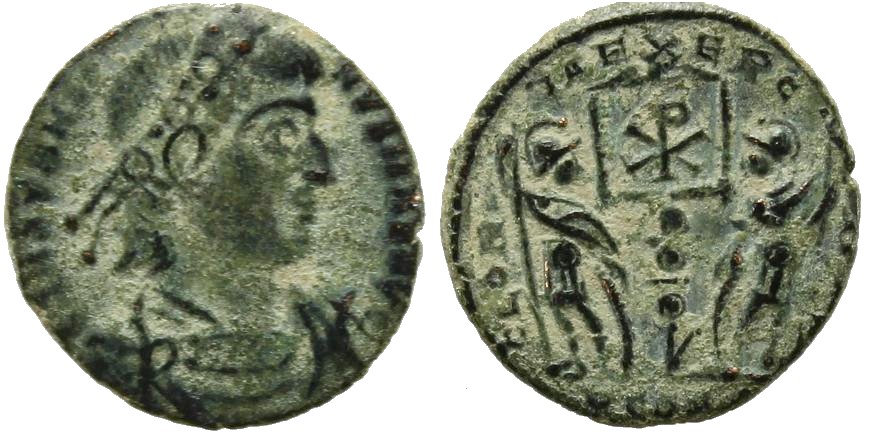
Constans: Siscia mint, 337-340 CE: | A1076a. Bronze AE3/4, RIC 87, gem about uncirculated, bold, sharp, outstanding, 1.70g, 17.4mm, 180°, Siscia mint, 337-340 A.D.; obverse CONSTANS P F AVG, laureate, draped and cuirassed bust right; reverse GLORIA EXERCITVS, two soldiers flanking labarum (chi-rho standard), GSIS ex; scarce 
Constantius II: Siscia mint, 337-340 CE: | 2197. RIC 241, S 4001, VM 85, VF, 2.0g, 17.9mm, Siscia mint, 337-340 A.D.; obverse D N CONSTANTIVS P F AVG, pearl-diademed, draped and cuirassed bust right; reverse FEL TEMP REPARATIO (happy days are here again) Constantius standing left in a galley, holding labarum (chi rho Christogram standard) and Phoenix on globe, Phoenix holds a wreath, Victory seated in stern steering ship, ESIS and symbol in ex 
Magnentius - usurper of the Roman Empire from 350 to 353: | Double Centenionalis Magnentius; XR, s4017 
Vetranio: Siscia mint, 350 CE: | A1174. Bronze Centenionalis, RIC 290, EF, fine near black patina, 3.84g, 22.8mm, 0°, Siscia mint, 350 A.D.; obverse D N VETRANIO P F AVG, laureate, draped and cuirassed bust right, A left, * right; reverse CONCORDIA MILITVM, Vetranio standing left, star above head, holding a labarum (chi-rho standard) in each hand, A left, ·ASIS* in ex; scarce 
Missorium of emperor Constantius II, 350 CE: | Constantius II accompanied by a guardsman with the Chi-Rho depicted on his shield 
Jovian: Thessalonica mint, 364 CE: | A1216. Bronze AE1, RIC 238 variety, choice VF, nice near black patina, 8.31g, 27.5mm, 180, Thessalonica mint, 363-364 A.D.; obverse D N IOVIANVS P F AVG, pearl- diademed, draped and cuirassed bust right; reverse VICTORIA ROMANORVM, Jovian standing right, head left, holding Victory on globe in left and labarum (chi-rho standard) in right, ·TESG· in ex 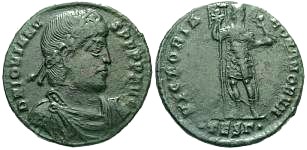
Sarcophagus of Domatilla; mid 4th century: | Now in the Museo Pio Christiano, Rome. Chi-rho symbol atop cross, soldiers below. 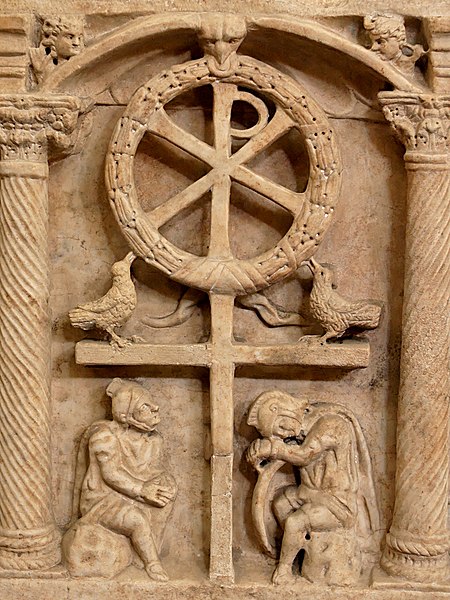
Constantine: Early 4th century mosaic: | The Hinton St Mary Mosaic is a large, almost complete Roman mosaic discovered at Hinton St Mary in the English county of Dorset. It appears to feature a portrait bust of Constantine as its central motif. The mosaic covered two rooms, joined by a small decorated threshold. It is largely red, yellow and cream in colouring. On stylistic grounds it has been dated to the 4th century and is attributed to the workshop of the Durnovarian school of mosaic art. 
Britain, Mid 4th century: | The only gold item in the Water Newton Treasure a Votive plaque, item BM ref:1975,1002 
Britain, Mid 4th century: | Part of the Water Newton Treasure - a hoard of fourth-century Roman silver - discovered near the Roman town of Durobrivae at Water Newton in the English county of Cambridgeshire. The hoard consisted of 27 silver items, many of which are votive tokens engraved and embossed with the labarum (the chi-rho cross). 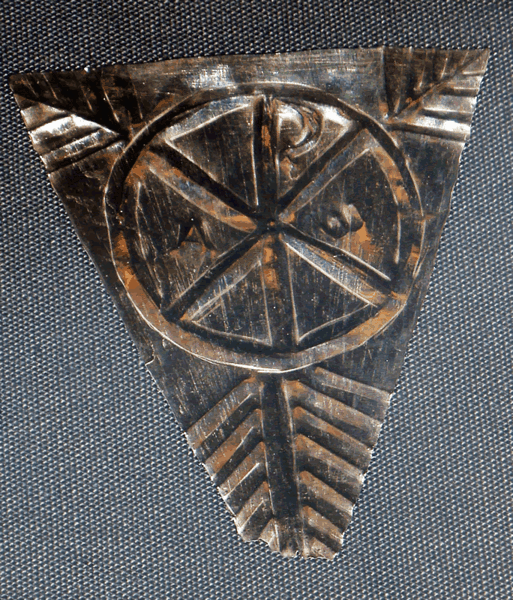
Water Tank: Roman Britain, 4th century CE | British Museum: This lead tank is one of three found at Icklingham, Suffolk, where an early church and cemetery have been excavated. On the side of the tank in two places is the common Christian device of a Chi-Rho symbol, the first two letters of Christ's name in Greek. This is flanked by an alpha and omega, the first and last letters of the Greek alphabet, another symbol of Christ - 'I am Alpha and Omega, the first and the last' (Revelation 1:8). There is no conclusive evidence that the lead tanks were used as fonts, but they were presumably intended to hold water. Although the chi-rho is correctly marked, the positions of the alpha and omega have been reversed. While this may have had religious significance, it is just as likely to have been the result of a mistake in the casting process by someone unaccustomed to the Greek alphabet. Also see A Group of Romano-British lead tanks fromLincolnshire and Nottinghamshire ... "A total of twenty-three whole or partial circular lead tanks ascribed a Romano-British date have been recorded from Britain (Elliott and Malone 2005; pace Worrell 2005 who adds, in fact, the twenty-third). They have a largely eastern distribution, with the majority by far recovered in the East Midlands and East Anglia. 
Britain, Mid 4th century: | The Hoxne Hoard is the largest hoard of late Roman silver and gold discovered [16 November 1992] in Britain, and the largest collection of gold and silver coins of the fourth and fifth century found anywhere within the Roman Empire. Although the coins of the hoard range between 364-408 CE, the Chi-Rho appears on a number of decorative spoons, a ladle, and as a clasp on a necklace. Showing the 13 cm (5.1 in) long "ladle" from the hoard, with decoration including a Chi-Rho and sea-creatures Britain, Mid 4th century: | The Mildenhall Treasure is a major hoard of highly decorated Roman silver tableware from the fourth-century CE, found at West Row, near Mildenhall in the English county of Suffolk. It consists of two large serving platters, two small decorated serving plates, a deep fluted bowl, a set of four large decorated bowls, two small decorated bowls, two small pedestalled dishes, a deep flanged bowl with a deep, domed cover, five small round ladles with dolphin-shaped handles, and eight long-handled spoons, of which three (29-31) are all inscribed within the bowls with the Chi-rho monogram, flanked by the latters alpha and omega. Not presently having an image of these Chi-Rho spoons, instead the image here is of the Great Dish (also known as the Oceanus Dish or as the Neptune Dish, from the face of a sea-god at its centre), which measures 605 mm in diameter and weighs 8256 g, is the outstanding piece of the entire hoard. The decoration, which was worked by chasing from the front, is in three concentric zones. In the centre, the head of a marine deity, probably Oceanus, the personification of the ocean, is shown full-face, with a beard made of seaweed and dolphins emerging from his hair. This portrait is surrounded by a narrow inner frieze of decoration populated by nereids (sea-nymphs), tritons and other mythical and natural sea-creatures, while the deep outermost zone carries imagery of the Bacchic thiasos, the dancing, music-making and drinking revels of the god Bacchus. More specifically, the triumph of Bacchus over Hercules is depicted. Hercules is shown staggering drunkenly and supported by two helpful satyrs. Bacchus himself appears with his panther and Silenus at the '12 o'clock' position on the circle in relation to the orientation of the Oceanus head, so that in most illustrations of the dish, he is seen upside-down at the top of the picture. The god Pan also appears in the composition, dancing and brandishing his pan-pipes, as do several dancing Maenads, the female devotees of Bacchus, and satyrs. The entire design is traditionally pagan, and is superbly executed. 
"The Caesars" a satire authored by Emperor Julian c.361 CE:
"And what was the height of your ambition?"
"To amass great wealth," 
| |||||||||||||||||||||||||||
|---|---|---|---|---|---|---|---|---|---|---|---|---|---|---|---|---|---|---|---|---|---|---|---|---|---|---|---|---|---|---|---|---|---|---|---|---|---|---|---|---|---|---|---|---|---|---|---|---|---|---|---|

Index | Nag Hammadi | Gnostic C14 | TAOPATTA | Leucius Charinus | Leucian "Acts" | Mountain Man Graphics